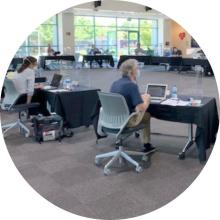Positioning the Laboratory for continuing excellence in science and technology directed at important national missions
FY 2020 was a year of engagement with sponsors and stakeholders, providing technical leadership in key mission areas, and building for future successes.
Strategic Leadership
LLNL is strongly focused on its national security mission and works closely and effectively with DOE and NNSA, as well as other sites in the NNSA complex, research partners, and other work sponsors to ensure accomplishment of program objectives. Our strategic plans closely align with NNSA’s strategic vision and are central to its success. With the W80-4 life-extension and the W87-1 modernization programs, Livermore is working with NNSA’s production facilities to bring modern manufacturing processes into the NNSA nuclear security enterprise (NSE) to make it more cost effective, agile, and responsive. The combination of high-performance computing simulations, experimental testing, and machine learning that are supporting stockpile modernization have many other mission applications.
Livermore is also providing leadership to NNSA in the development and application of data-intensive, mathematical models to support decision making regarding the stockpile, workforce, infrastructure, and costs. Based on NSE data compiled over the past 15+ years, these models are used to evaluate the NNSA program of record for customers across the NSE. They also have been instrumental in planning investments to modernize the NSE’s aging infrastructure. Detailed consideration must be given to the condition of facilities and equipment, their importance to mission success and consequences of their failure, whether to refurbish or replace, and managing yearly costs in the face of constrained budgets.
New Facilities and Modernized Infrastructure
In early FY 2020, doors opened for research collaborations at LLNL’s Advanced Manufacturing Laboratory, sited at the Livermore Valley Open Campus. The new 14,000-square-foot one-of-kind facility houses leading-edge additive-manufacturing machines and equipment. In addition, a ribbon-cutting ceremony officially opened the Applied Materials and Engineering (AME) campus during the NNSA administrator’s visit to LLNL at the end of FY 2020. Created through a novel approach to infrastructure modernization featuring area plans, the campus includes three new buildings together with several existing facilities. It will significantly reduce the existing site footprint by consolidating capabilities that are critical to stockpile modernization. AME will feature a polymers laboratory; advanced manufacturing including 3D printing, brazing, and welding; and office and collaborative space.
In June, construction began on the Exascale Computing Facility Modernization (ECFM) project. ECFM serves to meet LLNL infrastructure demands over the next decade for two future exascale computer systems. The first, El Capitan, will arrive in 2023 (see Sierra Supercomputer and Beyond). The extensive ECFM project will involve upgrading Building 453, where El Capitan will be housed, and constructing infrastructure to provide necessary additional power and cooling. El Capitan will provide critically needed computing capability for the W80-4 life-extension and W78-1 modernization programs. In addition, a groundbreaking ceremony in September launched construction of a new Emergency Operations Center (EOC). The 20,550-square-foot facility will consolidate emergency response functions and provide 24/7 operations. The EOC is an NA-50 Pilot Project to streamline commercial-like Line Item projects in the $20–$50-million total cost range. It is designed to survive earthquakes and will be self-sustaining for up to 72 hours before needing resupply. City, county, state, and federal emergency personnel also will have access to the new facility.
A Changing Workforce
An outstanding workforce is Livermore’s principal strength. Recruiting, training, and retaining the best and brightest are top priorities at LLNL to sustain excellence at a time of rapid change in our workforce. Many senior staff members have been retiring and nearly 50 percent of the core staff have been hired within the last six years. The incoming employees bring impactful new ideas to their jobs, work with integrity and zeal, and thrive in an inclusive work environment. In December 2019, Glassdoor recognized LLNL as one of the top 10 best places to work nationwide. Its Employees’ Choice Award program is based on employees’ input on their jobs and work environments.
Despite the ongoing pandemic, FY 2020 was a successful year of hiring. LLNL’s Strategic Human Resources Management (SHRM) department established new processes to expedite hiring and after COVID-19 struck, quickly developed means to virtually on-board new staff. Using this New Employee Orientation process, SHRM brought into LLNL about 450 new employees, more than 60 postdoctoral fellows, nearly 400 students and faculty scholars, and supplemental labor personnel.
LLNS Board of Governors Activities
The LLNS Board of Governors and its committees provide oversight to the Laboratory and delve into issues crucial to mission and mission-support activities. External review committees (ERCs), panels of independent experts including Board members, periodically met in FY 2020 to critically assess the quality of LLNL’s technical workforce and the effectiveness of research efforts in meeting mission goals and future national needs. Their reports, which provided DOE/NNSA with an independent validation of work quality, consistently affirmed the mission relevance and high impact of Laboratory research. The Board chartered functional management reviews (FMRs) on an as-needed basis. Eight FMRs, both virtual and in-person, were completed in FY 2020 in topical areas ranging from Commercial Practices to Oversight During the Pandemic. Recommendations provided by Board committees, ERCs, and FMRs have led to substantive responsive actions.
Helping Employees
Recognizing the importance of the well-being of Laboratory staff and their families, LLNL has offered employees help in managing health care issues and difficult work/life balance demands during the pandemic. Authorized leave was made available for use by employees at the onset of local COVID-19 shelter-in-place orders. Staff were allowed to be advanced 80 hours of sick leave if needed and were given latitude to use more of their sick leave time to care for others. The Lab Employee Services Association (LLESA) “went virtual” with many of their offered activities and in July, more fully opened the LLESA Children’s Center, which operates in compliance with strict local and state restrictions and licensing guidelines.








